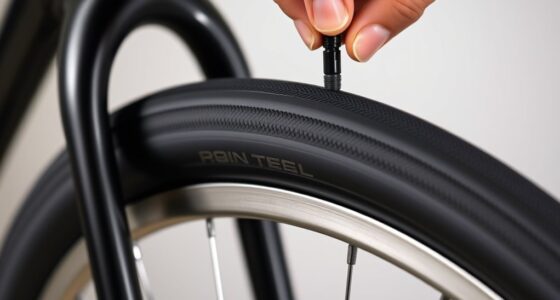To choose a safe helmet, look for certifications like CPSC, ASTM, or EN standards, which show it has passed rigorous impact tests. Make sure it fits snugly and sits level on your head, with adjustable straps for comfort. Focus on helmets with strong foam liners, good ventilation, and extra safety features like MIPS. Regularly check for wear and replace when necessary. Keep these tips in mind to protect yourself better—more details await to guide your choice.
Key Takeaways
- Verify helmets have safety certifications like CPSC, ASTM, or EN standards to ensure impact protection and compliance.
- Properly fit helmets snugly on the head, covering the forehead, with adjustable straps and padding for comfort and safety.
- Choose helmets with advanced impact absorption features such as multi-density foam liners and MIPS technology.
- Prioritize helmets with good ventilation, comfort, and visibility features like reflective elements for safer riding.
- Regularly inspect and replace helmets if damaged or worn to maintain optimal safety performance.
Understanding Common Helmet Safety Certifications
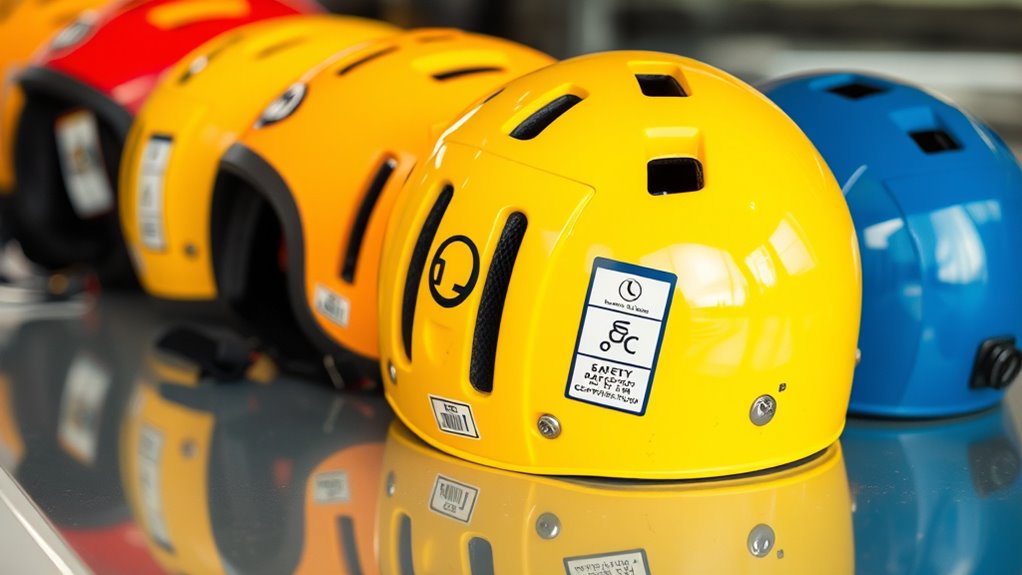
To guarantee your helmet provides adequate protection, it’s important to understand the safety certifications manufacturers seek. These certifications ensure helmets meet safety standards and can withstand impacts. Look for marks like CPSC, ASTM, or EN standards, which indicate the helmet has undergone rigorous testing. While safety is key, don’t forget about helmet decoration and helmet color options—they can help you personalize your gear while maintaining safety compliance. Choosing a helmet with the right certification guarantees it’s built to protect you during falls or collisions. Remember, the certification labels are usually found on the inside or back of the helmet. Prioritizing certified helmets means you’re investing in safety first, with style and personalization options like helmet color choices and decorative elements to match your preferences. Additionally, selecting helmets that meet diverse safety standards ensures better impact protection and durability during use. Being aware of regulatory compliance can also help you select helmets that adhere to evolving safety laws and industry standards. Staying informed about different safety standards can further enhance your confidence in choosing the best protective gear. Furthermore, understanding the digital literacy programs related to safety can help seniors navigate helmet options more effectively. Incorporating helmet fit and proper sizing is also essential for optimal protection and comfort.
Key Factors to Consider When Selecting a Helmet
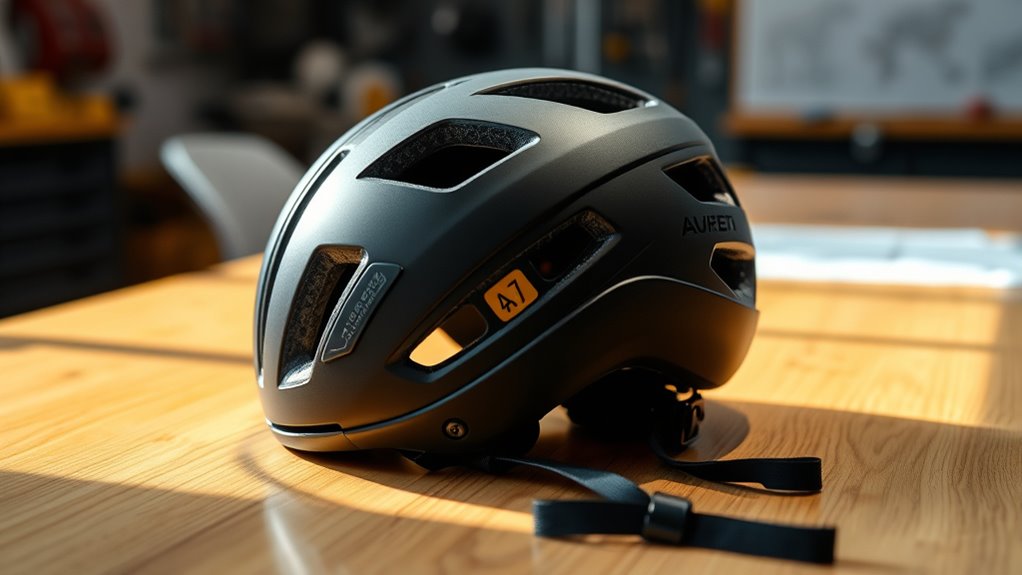
When selecting a helmet, you need to take into account several key factors to guarantee it provides ideal protection and comfort. First, consider the helmet material—look for durable, impact-absorbing shells like polycarbonate or fiberglass. Second, evaluate the aesthetic design; choose a style and color that you like, boosting your confidence and visibility. Third, make certain the helmet fits snugly without pressure points, which is vital for safety and comfort. Fourth, check for adjustable straps and ventilation systems to enhance fit and airflow during rides. Remember, a well-designed helmet with the right material and aesthetic appeal not only keeps you safe but also encourages consistent use. Additionally, ensuring the helmet meets safety standards, such as CPSC certification, is crucial for reliable protection. It’s also beneficial to consider helmet testing procedures that confirm the helmet’s ability to withstand impacts. Incorporating comfort features like padding and moisture-wicking liners can significantly improve your riding experience. A proper helmet that meets these security standards can reduce injury risks and provide peace of mind. Furthermore, selecting a helmet with protective features designed to absorb shocks can enhance overall safety. Prioritize these factors for a reliable, comfortable helmet that suits your needs.
How to Read Helmet Labels and Standards
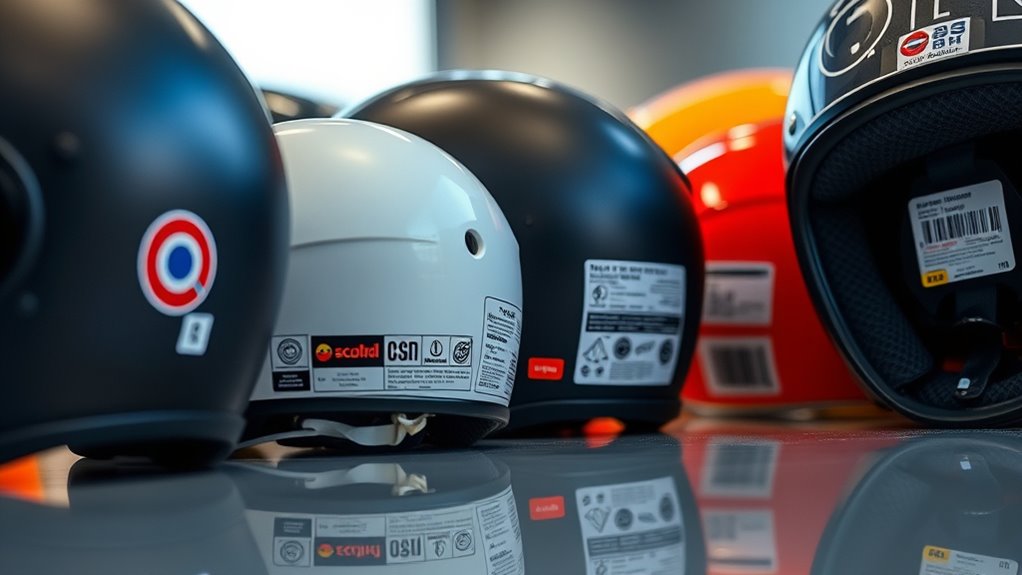
Understanding how to interpret helmet labels and standards guarantees you’re choosing gear that truly offers the protection you need. Start by checking the helmet construction, which indicates the materials and safety features used, such as foam liners and impact-absorbing shells. Recognizing credit card security measures can also help you understand how safety protocols are implemented in various standards to protect users. Additionally, being familiar with Vetted – The Pinball Spot can help you access trusted safety information and reviews related to protective gear. Look for certification labels like CPSC, ASTM, or EN, which show the helmet meets strict safety standards. Pay attention to color visibility—bright, reflective colors enhance your visibility on the road, increasing safety. Labels often specify the helmet’s compliance with specific standards, so verify they’re current and appropriate for your activity. Reading these labels helps ensure your helmet is both safe and suitable. Additionally, familiarizing yourself with Fokos and safety standards can help you make more informed decisions when selecting protective gear.
The Importance of Proper Fit and Comfort

A properly fitting helmet keeps you safe and comfortable, so make certain you select the right size and adjust it correctly. Look for adjustable features that let you customize the fit to your head shape and guarantee it stays snug without causing discomfort. Additionally, understanding privacy policies can help you protect your personal data and maintain your online security. Being aware of helmet standards ensures your helmet meets safety regulations and provides reliable protection. Regularly inspecting your helmet for signs of wear and tear can prevent accidents caused by compromised safety features. Remember that expert advice can guide you in choosing the best helmet for your needs and ensure optimal safety.
Correct Helmet Sizing
Ensuring your helmet fits properly is vital for maximum safety and comfort. To do this, start by measuring your head accurately using a flexible tape measure around the widest part, just above your eyebrows. Proper helmet sizing is essential for effective protection and comfort. Additionally, be aware that helmet safety standards ensure that your helmet meets minimum safety requirements. Here are four tips to get the right fit:
- Use the measured head size to select a helmet labeled within that range.
- Try on different helmets to find one that feels snug but not tight.
- Ensure the helmet sits level on your head, covering your forehead comfortably.
- Check that the chin strap is secure without causing discomfort, as proper fit and comfort are crucial for safety.
- Remember that a well-fitting helmet can also enhance your confidence and overall riding experience, as proper fit can reduce distractions and improve focus during activity. Wearing a helmet with the correct adjustment features can further improve fit and safety.
Adjustable Comfort Features
Once you’ve found a helmet that fits snugly and comfortably, it’s important to contemplate adjustable comfort features that help maintain that perfect fit during your ride. Many helmets offer adjustable straps, removable padding, and fit systems like dial-adjusters to customize comfort. Incorporating adjustable features such as these ensures your helmet stays securely in place, reducing fatigue and distractions. When choosing a helmet, consider the available helmet color options to match your style and visibility needs. Additionally, think about helmet weight considerations; lighter helmets reduce strain, especially on longer rides. Properly adjustable comfort features allow you to personalize your helmet for ideal fit and comfort, making your riding experience safer and more enjoyable. Prioritizing these details helps you stay comfortable and confident every time you ride.
Proper Wearing Technique
Wearing your helmet properly is essential to maximize safety and comfort. A well-fitting helmet ensures protection without discomfort. Follow these steps to achieve the right fit:
- Adjust the helmet so it sits level on your head, covering your forehead about an inch above your eyebrows.
- Ensure the chin strap is snug but comfortable, with no excessive movement.
- Check that the helmet color is visible and enhances your visibility to others.
- Use helmet accessories like liners or pads for added comfort and a secure fit.
Additional Safety Features to Look For

When choosing a helmet, look for enhanced impact absorption to better protect your head during crashes.
Good ventilation can keep you comfortable and focused, especially on hot days.
These added features can make a significant difference in both safety and comfort during your activities.
Enhanced Impact Absorption
Enhanced impact absorption is an essential feature to contemplate because it greatly diminishes the risk of head injuries during accidents.
When a crash occurs, the helmet’s ability to absorb impact energy and mitigate shock is fundamental. Look for helmets with advanced foam liners designed for superior shock mitigation, which can better distribute impact forces.
Consider these features:
- Multi-density foam layers for better impact energy dissipation
- MIPS (Multi-directional Impact Protection System) technology for enhanced shock mitigation
- Thick, energy-absorbing padding around critical areas
- Reinforced shell structures to reduce force transfer to your head
Ventilation and Comfort
Proper ventilation and comfort are essential safety features because they help you stay focused and avoid fatigue during extended wear. Good helmets include ventilation mechanisms that promote airflow, keeping your head cool and reducing sweat buildup.
Breathability features like multiple vents and mesh liners allow air to circulate effectively, preventing overheating and discomfort. When choosing a helmet, look for designs that prioritize these aspects without compromising protection.
Well-ventilated helmets can improve your overall experience and safety by helping you maintain concentration during long rides or activities. Comfortable fit combined with proper airflow ensures you won’t be distracted or hindered by discomfort, allowing you to focus on your performance and safety.
Prioritize ventilation and breathability features to enjoy a safer, more comfortable helmet experience.
Maintaining and Replacing Your Helmet Over Time
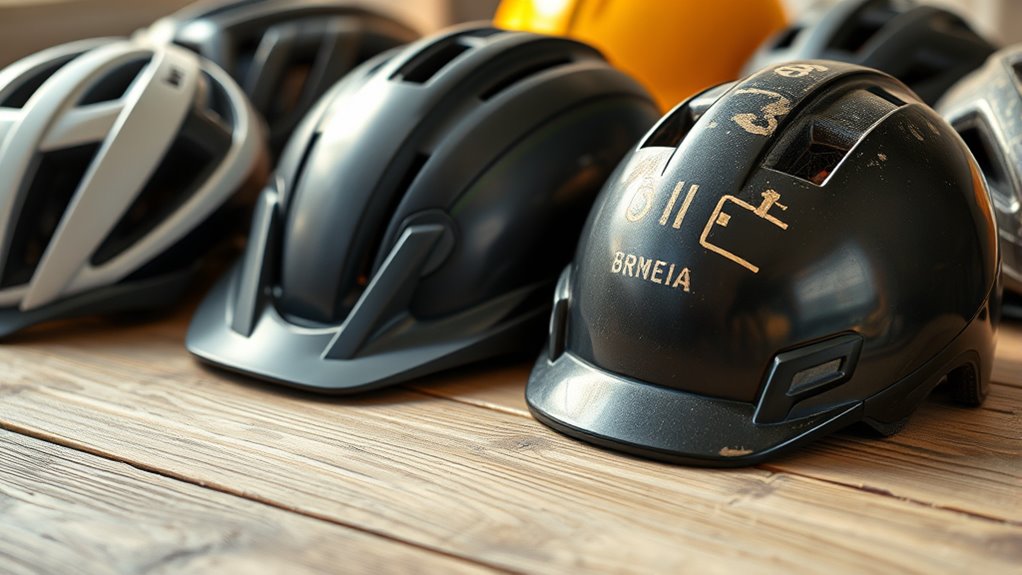
Regularly inspecting your helmet is essential to guarantee it continues to provide adequate protection. Over time, impacts, wear, and exposure to elements can compromise its safety features.
Keep an eye out for these signs:
- Cracks or dents in the helmet shell or foam core.
- Fading helmet color or fading logos, indicating prolonged sun exposure.
- Loose or damaged helmet accessories, such as straps or visors.
- Fitting issues, like a loose fit or discomfort, suggesting the interior padding has degraded.
When replacing your helmet, choose one with visible safety standards.
Updating helmet accessories, like reflective stickers or colorful helmet color options, enhances visibility.
Regular maintenance ensures your helmet stays effective and stylish.
Frequently Asked Questions
How Often Should I Replace My Helmet for Safety Reasons?
You should replace your helmet immediately after any significant impact, even if it looks fine, to ensure safety. Regular helmet maintenance, like cleaning and inspecting for cracks or damage, is vital.
Proper helmet storage in a cool, dry place also helps preserve its integrity. Consider replacing your helmet every 3 to 5 years, as materials can degrade over time, reducing protection.
Always prioritize safety to stay protected during rides.
Are There Specific Helmets for Different Sports or Activities?
Imagine wearing a helmet designed for snowboarding while mountain biking—that’s like bringing a knife to a gunfight! You need sport-specific designs and activity-specific features to stay safe.
Different sports demand different protection levels, venting, and fit. Helmets tailored to your activity ensure maximum safety and performance.
Always choose helmets made for your specific sport or activity, and you’ll be better protected against unexpected falls or impacts.
Can Custom-Fit Helmets Improve Safety and Comfort?
Custom-fit helmets can substantially improve safety and comfort. When you opt for a custom fit, the helmet molds perfectly to your head’s shape, reducing pressure points and enhancing stability during activity.
This comfort boost encourages consistent wear, which is essential for safety. Plus, a well-fitted helmet minimizes movement, offering better protection in case of impact.
Ultimately, a custom fit makes your helmet safer and more comfortable for active use.
What Is the Lifespan of a Typical Helmet?
Like the fleeting nature of a sunset, your helmet’s lifespan is limited. Typically, a helmet made from durable materials like polycarbonate or fiberglass should be replaced every 5 to 7 years, even if unused.
Impact testing can reveal subtle damage, but over time, materials deteriorate. Regular inspection and awareness of wear and tear ensure your helmet continues to protect you, maintaining safety and comfort on every ride.
Do Helmet Safety Standards Vary Internationally?
You’ll find that helmet safety standards do vary internationally, mainly due to differences in international regulations and compliance standards. Some countries have strict requirements, while others may have more relaxed rules, impacting helmet quality and safety.
It’s essential to verify local regulations to ensure your helmet meets the necessary safety standards. Always look for certification labels, like CE or DOT, to confirm compliance with regional safety standards.
Conclusion
Choosing the right helmet gently guides you toward safer adventures. By paying attention to standards, fit, and features, you’re stitching together a confident, comfortable experience. Remember, a well-cared-for helmet quietly guards your journey, whispering safety with every ride. Keep it snug, replace when needed, and trust your instincts. In the end, your thoughtful choices weave a seamless shield—allowing you to enjoy every moment with peace of mind and a sense of quiet assurance.


